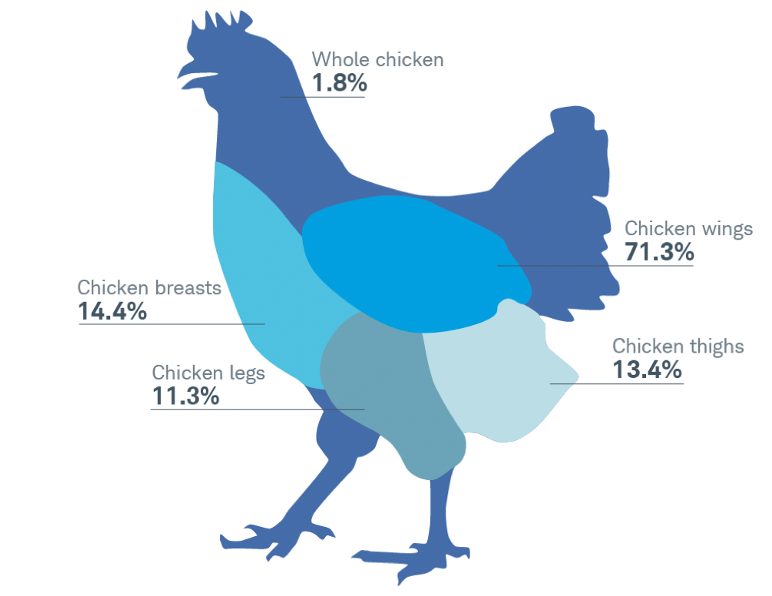Pieces vs Whole—Important consideration when planning TCO

I received this image through one of the investor firm newsletters. It explains the percentage cost increase of the whole chicken and the chicken parts over a period. As the graphic shows, the cost of various parts of the chicken has increased by a significant percentage compared to the price of the whole chicken. It made me think that an increase in the cost of anything complete, all-inclusive is relatively predictable, stable, and lower than the cost increases of high-demand parts. This pricing comparison is analogous to how an Enterprise Data Management Platform vs. a point product solution offering only data protection would also compare.
For comparison purposes, let’s say that chicken wings are like virtual workloads in the enterprise data protection world. Most data protection/data management vendors focus a good amount of their resources and products only on that workload. Some appear to have been so open about their narrow focus that they have even named their company after the workload. These vendors often claim that covering virtual workloads is sufficient. However, that claim starts falling apart when you consider large enterprises that rely on more than just virtual workloads (or chicken wings to continue the comparison).

Percentage customer cost increase of various chicken parts and whole chicken
Sources: Bureau of Labor Statistics and U.S. Department of Agriculture. Data from January 2020 to July 2021
Large organizations have a variety of applications in their environments essential for their business sustenance and growth. Some vendors who primarily sell chicken wings (virtual workload support) might also sell chicken legs (NAS workload protection) to help meet a broader customer base. However, there is still an unmet need for the rest of the chicken (workloads). You will need to hire even more vendors to fulfill those additional needs.
As organizations add together more point products to protect all workloads, issues arise. For example, only a few vendors consider the deduplication of all backup data as a must-have. Additionally, with the multi-vendor strategy there is a difference in licensing meters: one vendor may charge by weight (i.e. metering by FETB), while the other may charge by quantity (i.e. number of VMs). That is precisely where the problem with a predictable TCO starts.
There are technologies commonly used by all the vendors, and sometimes, there may be a fatal security flaw or some other issue with the common technology. It is a pure coincidence that log4j vulnerability showed up to prove my point, which cuts across lot of products and vendors. Coming back to our chicken analogy, the chicken wings and chicken legs vendors (Virtual and NAS protection vendors) will fix it quickly. Still, it most likely won’t be sufficient for large enterprise customers. Does it mean that large enterprises should suddenly stop consuming the rest of the chicken parts (Workloads like Bare Metal, DB2 workloads which are other than Virtual and NAS workloads)? Most certainly not!
Moreover, individual vendors supporting less popular workloads such as virtual and NAS, may add the cost of the fix to their point products, if they switch to better but expensive technology. As a result, large enterprises pay for the increased cost to multiple vendors and hence multiple times. You can see a parallel to this in your day-to-day life: gas. If the crude oil increases by 40 cents, you might end up paying four dollars more for gas at the pump because through each step of the oil processing and gas supply chain will add that price increase to each of their costs. A vendor with all-encompassing data services thus reduces the TCO increase due to any pivot or change in the underlying technology. Even if the price increases, customers bear that cost in 1: 1 proportion, not 1: many like the gas price increase.
Veritas is the only vendor that keeps adding new data sources for data protection, eDiscovery, and advanced supervision to the existing capabilities and coverage—keeping the cost predictable and manageable. In addition, the components of the solution are closely integrated, reducing administration overhead. The same is not true if you consider vendors selling only parts of the solution.
Veritas customers would see the correlation between the cost increase percentage of whole chicken vs. parts of the chicken. Suppose you have been our customer for decades and using our data services for availability, data protection, and digital compliance. In that case, you know that Veritas has made many technological changes over the years, increasing return on investment without any extravagant increase in the TCO. On the other hand, the dual vendor approach has shown to add cost. Bottom line, just looking at the quote you have in front of you may not be telling you the whole story. Compare your costs wholistically with a single vendor strategy to that of dual or triple vendor strategy. Are you paying way too much for data protection of just a part of your environment compared to the whole environment? Those are critical questions to ask and find answers to. Usually, complex decisions like these do better by applying machine learning/artificial intelligence. But as an exception, this one will benefit most from your human intelligence.
It is time to take some initiative and start having this important conversation with your leadership. Help them understand why your organization needs a complete data management platform. After all, having a more predictable and sustainable budget is beneficial for any size company.
Here is a selection of resources to help support your decision to choose Veritas Data Management Platform over other point products.
